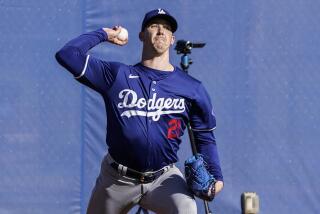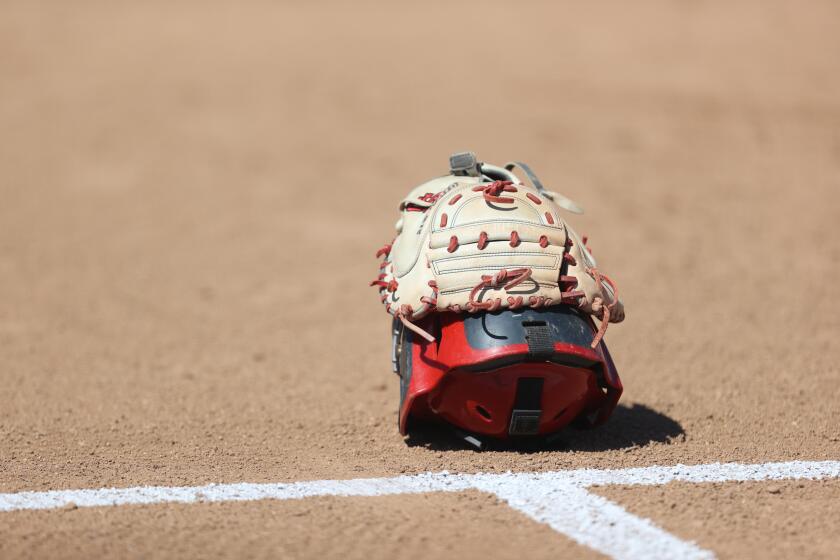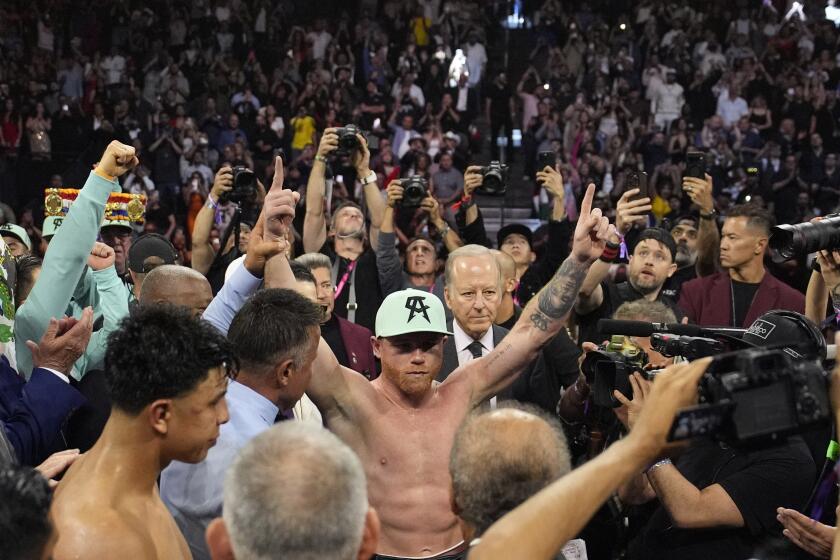The Shrine: It’s Lonely at the Top : Football: The lack of local players in All-Star Game is questioned. Local coaches blame the selection process, media inattentiveness and their own complacency.
Saturday’s 42nd annual Shrine All-Star Game will be no different from those of the past. As has been the tradition, Los Angeles’ inner-city schools will be poorly represented in the football classic.
Former Dorsey High standout Antonio Carrion is the only area player to make the roster for the game, which will pit all-star players from Northern California against their counterparts from Southern California at Veterans Memorial Stadium in Long Beach.
“From talking to the people at the Shrine, I get the feeling that they want to attract the really high-profile players,” said Carrion, who plans to attend San Diego State in September. “It has to do with who you are.”
Since 1951, 82 area players have competed in the Shrine Game. Only seven have played in the last 10 years and three--all from Dorsey--in the past five years.
Because the Shrine Game is a showcase for the state’s top high school seniors, the absence of area players has drawn questions about why more of Los Angeles’ inner-city athletes are not selected. The fault, local coaches say, lies in the selection process, media inattentiveness and complacency in their own ranks.
“It definitely isn’t a lack of talent,” Dorsey Coach Paul Knox said. “(Carrion) is one of the best athletes (Dorsey) has ever had. He was recognized more for his ability than his statistics. We are a running team, therefore Antonio’s numbers aren’t going to be very big (33 receptions for 762 yards and 11 touchdowns). But college scouts agreed that he was one of the top players on the West Coast based on his yards per catch (23.1).”
Nate Grosher, managing director of the Shrine Game, said players selected for the team solely “are measured by statistics and coaches’ evaluations.”
“The only reason I can think of that more (Los Angeles inner-city) players don’t make the team is because they don’t measure up statistically or they turned down their invitation to play,” he said. Grosher added that the ballots for this year’s nominations have already been destroyed and he therefore could not confirm whether any local players were invited and declined to attend.
In some cases, the numbers suggest that some local players are statistically equal, if not superior, to their counterparts who have been named to the game.
For example, Jason McCorvey of Long Beach Poly, who will play opposite Carrion at flanker, had 800 receiving yards last season, while Locke’s Brian Clarke caught 46 passes for 1,143 yards last season.
No one suggests that the players selected for the game are not deserving. The problem, coaches from Central Los Angeles say, is that word of their players’ accomplishments is not widely circulated--a factor they blame on themselves and the Los Angeles media.
“People who live outside the city have a poor perception of the football played in the city, except for a few major programs like Banning and Carson that are written about in the paper,” Knox said.
Bishop Amat Coach Mark Parades, who will coach the South, said it is the coaches’ responsibility to promote the players.
“Getting kids the publicity is the job of the coaches,” Parades said. “The coaches should sell their kids to the papers and the college recruiters. I make sure that my local newspaper (the San Gabriel Valley Tribune) knows about my players and their accomplishments. I give them names of kids to watch, so they will be aware. It’s not the newspapers’ job, it’s the coaches’ job to inform the newspapers.”
South Gate Coach Gary Cordray added: “A big problem was that people don’t know who the players are because the coaches aren’t lobbying to get their players on the (Shrine) teams.”
This year, Cordray was named president of the Los Angeles Football Coaches Assn., an organization that attempts to deal with problems surrounding high school football. In that role, Cordray said he wants “to educate coaches in L.A. on how to get their players on the Shrine list so they can get voted for. Many of the coaches aren’t even turning in their ballots.”
The selection process begins when the Shriners Club of Los Angeles sends out ballots to every high school and college coach in the state. Completed ballots are returned and tallied into one master ballot.
The master ballot is forwarded to a selection committee, whose members are:
* Bud Dyer of the Amateur Athletic Foundation,
* Jim Duel of the California Interscholastic Federation,
* Bob Bias of the Southern Section CIF,
* Cordray of the City Section CIF,
* Eric Shepard, prep sports editor of the Los Angeles Times.
This committee, with consideration given to recommendations by Shrine members, selects a roster of the top players from Northern and Southern California. (The Shrine Game went back to a Northern California vs. Southern California format in 1987. Due to budget problems, it was played between all-stars from the northern and southern regions of Southern California, from 1959 to 1986).
Knox believes having Cordray as a member of the selection committee will help increase representation from the inner city.
“Inner-city coaches have not been represented on the selection committee in the past,” Knox said. “I was glad to see Gary become a member because he will let the other (members) know how good our kids are.”
And there have been some good ones.
Perhaps the most notable Shrine snub was Washington High’s James Lofton in 1974. Lofton played wide receiver for the Green Bay Packers and Buffalo Bills of the National Football League before joining the Raiders this year. He is the NFL’s all-time leading receiver with 13,821 yards.
“James didn’t make the Shrine Game because no one knew about him,” said Cordray, who was a junior varsity coach at Washington during Lofton’s junior and senior years. “Eventually he got a scholarship to Stanford, but it took him a long time because no one gave him much credit.”
This quest for credibility and recognition has long been a plight for Los Angeles’ inner-city athletes.
“I’m going to do my best to make sure that the inner city receives its due from now on,” Cordray said. “I’ll definitely see to that.”
More to Read
Get our high school sports newsletter
Prep Rally is devoted to the SoCal high school sports experience, bringing you scores, stories and a behind-the-scenes look at what makes prep sports so popular.
You may occasionally receive promotional content from the Los Angeles Times.






